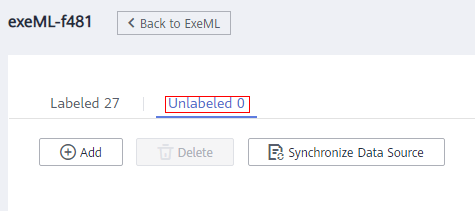Training a Model
After labeling the images, perform model training to obtain the required image classification model. Ensure that the labeled images meet the requirements specified in Prerequisites. Otherwise, checking the dataset will fail.
Prerequisites
- The number of labeled images in your dataset is greater than or equal to 100.
- At least two classes of samples are required for training, and each class with at least 5 samples.
Procedure
- Ensure all your dataset has been labeled. For details, see Labeling Data.
Figure 1 Finding unlabeled data

- In the data labeling phase of the new-version ExeML, click Next and wait until the workflow enters the training phase.
- Wait until the training is complete. No manual operation is required. If you close or exit the page, the system continues training until it is complete.
- On the image classification phase, wait until the training status changes from Running to Completed.
- After the training, click
 on the image classification phase to view metric information. For details about the evaluation result parameters, see Table 1.
on the image classification phase to view metric information. For details about the evaluation result parameters, see Table 1.
Table 1 Evaluation result parameters Parameter
Description
Description
Recall
Recall
Fraction of correctly predicted samples over all samples predicted as a class. It shows the ability of a model to distinguish positive samples.
Precision
Precision
Fraction of correctly predicted samples over all samples predicted as a class. It shows the ability of a model to distinguish negative samples.
Accuracy
Accuracy
Fraction of correctly predicted samples over all samples. It shows the general ability of a model to recognize samples.
F1 Score
F1 score
Harmonic average of the precision and recall of a model. It is used to evaluate the quality of a model. A high F1 score indicates a good model.

An ExeML project supports multiple rounds of training, and each round generates an AI application version. For example, the first training version is 0.0.1, and the next version is 0.0.2. The trained models can be managed by training version. After the trained model meets your requirements, deploy the model as a service.
Feedback
Was this page helpful?
Provide feedbackThank you very much for your feedback. We will continue working to improve the documentation.See the reply and handling status in My Cloud VOC.
For any further questions, feel free to contact us through the chatbot.
Chatbot





